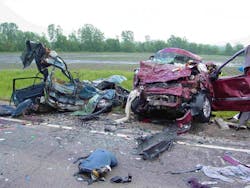Today, though, the “dichotomy” I’m referencing touches on the at-odds trend lines now developing roadway fatalities: while they are declining dramatically on a regional basis, especially in Europe, for the last six months they’ve been spiking here at home.
First, let’s start with the “big” picture, though it’s not a true global snapshot. According to recent analysis by the International Road Traffic and Accident Database (IRTAD) – an information collection group maintained by the Organisation for Economic Co-operation and Development (OECD) and the International Transport Forum (ITF) – provisional data for 2014 shows that for 15 of the 28 IRTAD member countries, the number of road deaths declined, while eight countries witnessed an increase and the remaining five experienced no significant change.
Overall, the biggest decline in roadway deaths measured 21% on the low end according to IRTAD’s findings while the biggest spike topped 16% on the high end.
Now for the sad statistics: Traffic deaths in the U.S. have increased every month for the past six months compared with the same months in 2014, according to the National Safety Council (NSC).
Unfortunately the groups expects that trend to continue into the summer months – already a period known as the “100 deadly days” – with the riskiest driving period beginning on Memorial Day and ending on Labor Day.To give you an idea just how deadly that three month stretch is on U.S. roadways, ponder this: some 48,579 people died in that June through August span since 2010.
“Summer is typically a high-exposure period with lots of miles driven and several long holiday weekends,” noted Deborah Hersman (seen at left), NSC’s president and CEO, in a statement and she thinks the recent spike in fatal car crashes – an 11% jump during the past three months and an 8% hike overall during the past six months – is due in part to an improving economy.
“Lower gas prices and lower unemployment rates often lead to an increase in traffic because more people can afford to drive, and many travel long distances and take vacations,” Hersman added. “Certain crash factors, such as speeding and alcohol, are more common during the summer, too. A yearly average of 2,781 deaths [in the U.S.] in June, July and August involve speeding, and 2,846 involve alcohol.”
Globally, however, a different picture is emerging.
IRTAD’s validated figures for 2013 indicate that the number of road fatalities fell by 4.3% between 2013 and 2012 in among its 32 member countries overall, with the long-term trend showing a very significant decrease of 42% between 2000 and 2013 among that group.Yet the economic downturn, which started hitting most IRTAD countries since 2008, is a big factor in this reduction of roadway fatalities, the group stressed – a point similar to what NSC’s Hersman noted above. IRTAD added that computer modeling work by the ITF shows that the “Great Recession” contributed to two-thirds of the reduction in roadway fatalities among the IRTAD’s member nations between 2008 and 2010.
And while deaths among motor vehicle occupants are declining rapidly, the same cannot be said for other “vulnerable road users” to use IRTAD’s nomenclature.
While the group said fatalities among car occupants fell by 54% between 2000 and 2013, they dropped only 36% for pedestrians, 35% for cyclists and 22% for motorcyclists. As a consequence, in many countries, road safety priorities have recently shifted from motorized rural traffic to vulnerable road users in urban areas, IRTAD noted.
On top of that, IRTAD’s group chair Fred Wegman noted that the organization’s 28 member nations only account for 6% of all global road fatalities.
Thus a lot more work remains to make the roadways safer for everyone in the years ahead.



